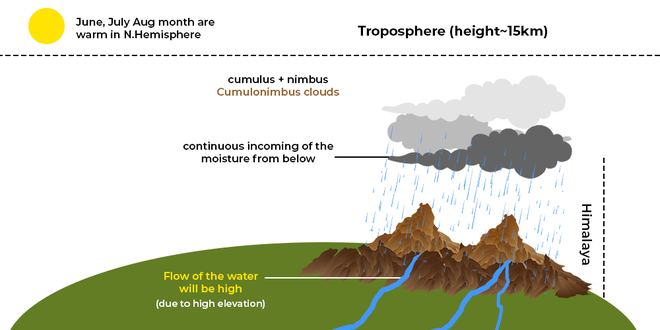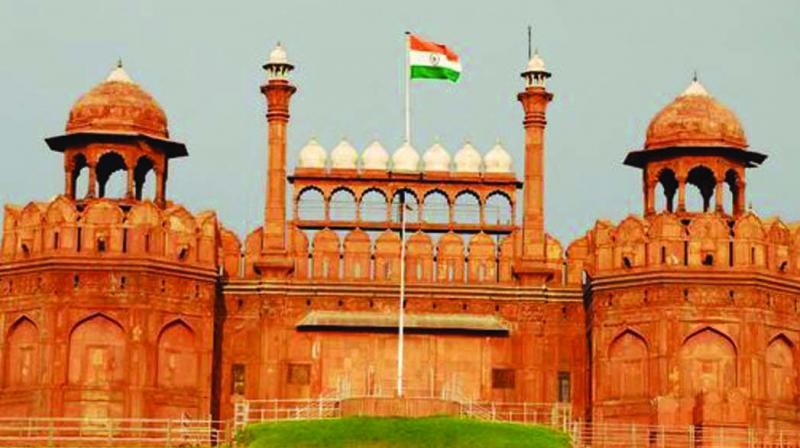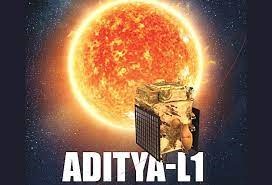Topics
- Cloudburst
- Vishwakarma Scheme
- Symbolism of Redfort for Independence Day
- Aditya L1 Mission
- California’s Redwoods
Understanding Cloudbursts: A Meteorological Phenomenon
Introduction
- After a period of heavy rainfall in Himachal Pradesh, landslides have been triggered in the region.
- This occurrence can be attributed to a meteorological phenomenon known as a “cloudburst.”
Defining a Cloudburst
- A cloudburst refers to an intense and localized episode of rainfall. Although it can manifest in flat terrains, it is most prevalent in mountainous regions.
- However, not all instances of substantial rainfall qualify as cloudbursts.
- The distinct criteria for identifying a cloudburst include a precipitation level of 10 cm or more within an hour across an area roughly measuring 10 km x 10 km.
- Consequently, if 5 cm of rainfall occurs within a half-hour period in the same area, it also qualifies as a cloudburst event.
Comparing to Average Rainfall
- In a typical year, India receives an average of around 116 cm of rainfall across its entirety.
- This translates to an even distribution of rainfall that would accumulate to a height of 116 cm if spread uniformly across the country.
- Despite substantial regional variations, an approximate average of 116 cm of annual rainfall is to be expected in any given location within India.
- A cloudburst, in contrast, involves a rapid accumulation of roughly 10% of this annual average within just an hour.
Frequency and Occurrence
- Cloudbursts are not rare incidents, especially during the monsoon season.
- These events are most prevalent in the Himalayan states due to the unique interplay of local topography, wind patterns, and temperature differences between different atmospheric layers.
- Cloudbursts are geographically limited, transpiring within small, often poorly instrumented areas.
- Nevertheless, their consequences reverberate beyond these confined spaces.
- Owing to the terrain’s characteristics, heavy rainfall from cloudbursts can induce landslides and sudden floods, inflicting significant damage downstream.
- This is why any intense rain spell causing destruction in hilly regions is colloquially referred to as a “cloudburst,” regardless of whether it strictly adheres to the established criteria for cloudburst classification.
Forecasting Challenges
- While the Indian Meteorological Department is adept at predicting rainfall events in advance, accurately estimating the extent of precipitation remains a challenge.
- Forecasts indicate possibilities of light, heavy, or very heavy rainfall but lack precision regarding specific quantities for individual locations.
- These forecasts cover relatively large geographical zones, typically at the district level.
- However, as forecasts narrow down to smaller areas, their accuracy diminishes.
- Regrettably, the precise prediction of cloudburst events at specific locations currently remains beyond the realm of meteorological capabilities.
Conclusion
Cloudbursts, characterized by their intense and rapid rainfall, are frequent occurrences in mountainous areas, often leading to landslides and floods.
Despite the challenges in forecasting their occurrence and magnitude, understanding their unique attributes is vital for mitigating their potential impacts.
VISHWAKARMA SCHEME
Introduction
The Prime Minister of India has recently introduced a noteworthy initiative known as the Vishwakarma Yojana, aimed at benefitting artisans.
Overview of the Scheme
- This scheme is specifically designed to uplift and bolster traditional industries operating within the Micro, Small, and Medium Enterprises (MSME) sector.
- It has been allotted a substantial budget of up to ₹15,000 crore, which will be directed towards fostering skill development among the younger generation.
Inclusion in the Budget
- This fiscal year’s budget included the unveiling of the Vishwakarma Yojana.
- The primary objective of this scheme is to provide support to traditional artisans and craftspeople.
- Its ultimate aim is to assist these individuals in enhancing the caliber, extent, and distribution of their products.
- This enhancement will facilitate their integration into the broader MSME value chain.
Key Components of the Scheme
- Financial Support: The scheme will provide financial assistance to eligible beneficiaries.
- Advanced Skill Training: Artisans will gain access to advanced training, enabling them to refine their skills.
- Modern Digital Techniques and Green Technologies: Beneficiaries will be equipped with knowledge about contemporary digital methods and eco-friendly technologies.
- Brand Promotion: The scheme will focus on promoting the brands of artisans and their products.
- Market Linkages: It will establish connections between artisans and both local and global markets.
- Digital Payments: The scheme will introduce digital payment solutions to facilitate smoother transactions.
- Social Security: Artisans will also receive social security benefits, ensuring their well-being.
Through these diverse components, the Vishwakarma Yojana strives to empower artisans and propel their integration into the broader economic landscape.
SYMBOLISM OF REDFORT FOR INDEPENDENCE DAY
Context:
- Every year on August 15, India commemorates its Independence Day with the hoisting of the national flag at the iconic Red Fort in Delhi.
- This historic tradition, initiated by Prime Minister Jawaharlal Nehru, holds deep significance in India’s journey towards self-rule and liberation from colonial rule.
The Significance and Architecture of the Red Fort
Historical Background and Construction
The Red Fort, also known as “Lal Qila” in Hindi, was constructed during the reign of the Mughal Emperor Shah Jahan. Its construction began in 1638 and was completed in 1648. It was designed to serve as the main residence of the Mughal emperors.
Architectural Marvel and UNESCO Recognition
A masterpiece of Mughal architecture, the Red Fort boasts red sandstone walls adorned with intricate marble decorations. It blends elements of Persian, Timurid, and Indian architectural styles. In 2007, it was designated as a UNESCO World Heritage Site due to its historical, cultural significance, and remarkable architectural design.
Layout and Features
The Red Fort’s imposing structure features walls extending over 2 kilometers. Its irregular octagonal layout includes two main entrances: the Lahore Gate and the Delhi Gate. Within its walls, stand the Diwan-i-Aam (Hall of Public Audience) and the Diwan-i-Khas (Hall of Private Audience), the former for addressing the general public and the latter for private meetings.
Historical Importance of the Red Fort
Delhi’s Role under Sultanate and Mughal Rule
Throughout the Delhi Sultanate and Mughal eras, Delhi emerged as a pivotal capital, symbolizing power. The Mughals established their dominion from the grandeur of the Red Fort, reinforcing their symbolic authority despite diminishing control.
Rebellion of 1857 and Symbolism
The Rebellion of 1857 underscored the symbolic significance of the Red Fort as rebels rallied around Mughal Emperor Bahadur Shah Zafar, using the fort as a rallying point for indigenous authority.
Impact of British Imperialism
British Rule and Transformation
After suppressing the Rebellion of 1857, the British repurposed the Red Fort as a British garrison, erasing its Mughal heritage. Despite this, they recognized its symbolic importance, as seen through the Delhi Durbars and the decision to shift the capital.
Red Fort and India’s Struggle for Independence
INA Trials and Nationalistic Sentiments
During the Indian National Army (INA) trials in the mid-1940s, the Red Fort regained prominence as a symbol of resistance against British oppression. These trials stirred nationalistic sentiments, highlighting the site’s significance.
Nehru’s Assertion of Independence
In 1947, Prime Minister Jawaharlal Nehru’s decision to hoist the national flag at the Red Fort symbolized the reclamation of the site from British colonial rule. This act marked the assertion of India’s sovereignty and the culmination of its struggle for freedom.
Annual Celebration and Symbolism
Continuing Tradition
The tradition of hoisting the national flag and delivering the Independence Day address from the Red Fort persists to this day.
Reclaiming Identity and Historical Significance
The annual celebrations at the Red Fort underscore the triumph of India’s struggle for independence and the reclaiming of its cultural and historical identity from colonial rule.
Aditya L1 Mission
Context
- The Indian Space Research Organisation (ISRO) recently released images from the Aditya-L1 mission, focusing on investigating the Sun’s secrets.
- The mission aims to observe the Sun from close proximity to gather insights into its atmosphere and magnetic field.
- The spacecraft is equipped with seven advanced payloads to study various aspects of the Sun’s behavior, including its corona, solar emissions, winds, flares, and Coronal Mass Ejections (CMEs).
Continuous round-the-clock imaging of the Sun is a central capability of the mission.
Significance of Solar Study:
- Solar weather and environment impact the entire solar system, influencing satellite orbits, operational lifespans, and onboard electronics.
- Solar disturbances can lead to power blackouts and disruptions on Earth.
- Understanding space weather is essential for tracking and predicting Earth-directed solar storms and their consequences.
- Lagrangian Point 1 (L1) is a critical location through which every solar storm heading towards Earth passes.
The Enigmatic L1 Point:
- L1 is a point in the Earth-Sun orbital plane where gravitational forces create regions of enhanced attraction and repulsion.
- Spacecraft can utilize these Lagrangian Points to optimize positioning and reduce fuel consumption.
- The Solar and Heliospheric Observatory Satellite (SOHO), a collaboration between NASA and ESA, resides at L1.
- L1 is situated about 1.5 million kilometers from Earth, providing a unique vantage point for studying the Sun.
Aditya-L1 mission’s exploration of the Sun’s mysteries holds substantial significance for understanding solar dynamics, mitigating potential impacts of solar events, and advancing space weather forecasting.






